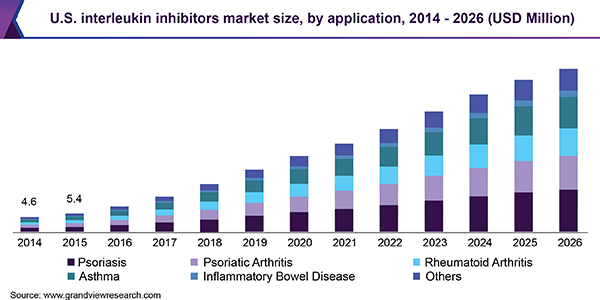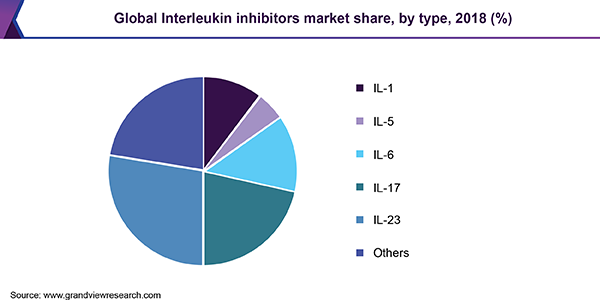- Home
- »
- Pharmaceuticals
- »
-
IL Inhibitors Market Size, Share, Industry Trends Report, 2019-2026GVR Report cover
![Interleukin Inhibitors Market Size, Share & Trend Report]()
Interleukin Inhibitors Market Size, Share & Trend Analysis Report By Application (Psoriasis, Psoriatic Arthritis, Rheumatoid Arthritis, Asthma, IBD), By Type (IL-17, IL-23), And Segment Forecasts, 2019 - 2026
- Report ID: GVR-3-68038-172-6
- Number of Report Pages: 103
- Format: PDF, Horizon Databook
- Historical Range: 2014 - 2017
- Forecast Period: 2019 - 2025
- Industry: Healthcare
Industry Insights
The global interleukin inhibitors market size was estimated at USD 20.7 billion in 2018 and is expected to exhibit a CAGR of 17.4% during the forecast period. Growing prevalence of autoimmune diseases and increasing adoption of interleukin inhibitors are expected to drive the IL Inhibitors market growth.
There has been a significant paradigm shift in the treatment of autoimmune diseases over the last few decades. The preference for targeted therapies is increasing due to their improved safety and efficacy profiles. Patent expiry and increased adoption of biosimilar in Tumor Necrosis Factor (TNF) inhibitors has raised the growth potential of the market.

New product launches are major growth rendering drivers, for instance, in 2019, AbbVie, Inc. launched Skyrizi (risankizumab-rzaa) for the treatment of plaque psoriasis. Earlier in 2018, Sun Pharmaceutical Industries Inc. launched Ilumya (tildrakizumab-asmn) for moderate-to-severe plaque psoriasis.
Demand is likely to be fueled by the impending launches of late-stage pipeline candidates. Label expansions of marketed products, such as Actemra for juvenile idiopathic arthritis and Dupixent for atopic dermatitis, are expected to further drive penetration. In addition, positive outcomes from ongoing clinical trials indicate the high growth potential of the IL inhibitors market.
Application Insights
Psoriasis captured the largest share among applications in 2018, driven by strong commercial performances of Stelara, Cosentyx, and Taltz. Increasing disease prevalence, rise in consumer awareness, and favorable reimbursement policies are significant contributors to growth.
Psoriatic arthritis is expected to experience the fastest growth over the forecast period, followed by Inflammatory Bowel Disease (IBD). Impending launches of late-stage pipeline products and label expansions of existing products indicated for psoriatic arthritis, Crohn’s disease, and ulcerative colitis, are key growth propellers.
Type Insights
IL-23 dominated the interleukin inhibitor types, largely driven by the blockbuster drug Stelara. Recent additions were made to the segment of Tremfya in 2017, Ilumya in 2018, and Skyrizi in 2019. Although Stelara continues to generate high revenue despite nearing patent expiry in 2023, the IL-23 segment is anticipated to witness strong growth driven by the anticipated new entrants.

IL-17 is estimated to be the fastest growing segment over the forecast period, which can be attributed to the high sales of Cosentyx and Taltz. Cosentyx became a blockbuster drug in 2017, its third year of launch, while Taltz is expected to cross USD 1 billion sales in 2019. In addition, the recent launch of Siliq and the impending approval of bimekizumab are expected to have a positive impact on the growth of IL-17.
Regional Insights
North America accounted for more than 70.00% share in 2018, owing to strong commercial sales of interleukin inhibitors in the U.S. Some of the other factors contributing to the growth are proactive government initiatives, increase in healthcare expenditure, and local presence of key manufacturers.
Asia Pacific is projected to observe the fastest growth throughout the forecast period. Economic development, improvement in healthcare infrastructure, increase in disposable income, and a rise in consumer awareness are likely to contribute to regional growth. Emerging countries, such as China, India, and South Korea, are expected to exhibit strong growth.
Interleukin Inhibitors Market Share Insights
Some key players are Johnson & Johnson Services, Inc.; Novartis AG; AbbVie Inc.; Eli Lilly and Company; Regeneron Pharmaceuticals, Inc.; AstraZeneca; Bausch Health; F. Hoffmann-La Roche Ltd; GlaxoSmithKline plc.; and Teva Pharmaceuticals Industries, Ltd. Companies are focusing on implementing strategies such as partnerships, distribution agreements, and regional expansion to increase their revenue share. For instance, Eli Lilly and Company is involved in developing Mirikizumab, an IL-23 product, which is currently under phase 3 trial. It is indicated for ulcerative colitis and psoriasis.
Report Scope
Attribute
Details
Base year for estimation
2018
Actual estimates/Historical data
2014 - 2017
Forecast period
2019 - 2026
Market representation
Revenue in USD Million & CAGR from 2018 to 2026
Regional scope
North America, Europe, Asia Pacific, Latin America, MEA
Report coverage
Revenue forecast, company share, competitive landscape, growth factors, and trends
Country scope
U.S., Canada, U.K., Germany, France, Italy, Spain, Mexico, Brazil, Argentina, Japan, China, India, South Korea, Australia, South Africa, UAE, Saudi Arabia
15% free customization scope (equivalent to 5-analyst working days)
If you need specific information, which is not currently within the scope of the report, we will provide it to you as a part of customization
Segments Covered in the ReportThis report forecasts revenue growth at global, regional, and country levels and provides an analysis on the latest industry trends in each of the sub-segments from 2014 to 2026. For the purpose of this study, Grand View Research has segmented the global Interleukin (IL) inhibitors market on the basis of application, type, and region:
-
Application Outlook (Revenue, USD Million, 2014 - 2026)
-
Psoriasis
-
Psoriatic Arthritis
-
Rheumatoid Arthritis
-
Asthma
-
Inflammatory Bowel Disease (IBD)
-
Others
-
-
Type Outlook (Revenue, USD Million, 2014 - 2026)
-
IL-17
-
IL-23
-
IL-1
-
IL-5
-
IL-6
-
Others
-
-
Regional Outlook (Revenue, USD Million, 2014 - 2026)
-
North America
-
The U.S.
-
Canada
-
-
Europe
-
Germany
-
France
-
The U.K.
-
Italy
-
Spain
-
-
Asia Pacific
-
Japan
-
China
-
India
-
South Korea
-
Australia
-
-
Latin America
-
Brazil
-
Mexico
-
Argentina
-
-
Middle East & Africa
-
South Africa
-
Saudi Arabia
-
UAE
-
-
Share this report with your colleague or friend.
![gvr icn]()
NEED A CUSTOM REPORT?
We can customize every report - free of charge - including purchasing stand-alone sections or country-level reports, as well as offer affordable discounts for start-ups & universities. Contact us now
![Certified Icon]()
We are GDPR and CCPA compliant! Your transaction & personal information is safe and secure. For more details, please read our privacy policy.
We are committed towards customer satisfaction, and quality service.
"The quality of research they have done for us has been excellent."





